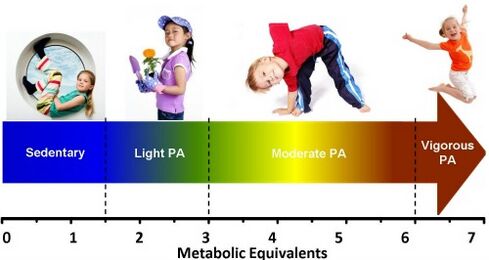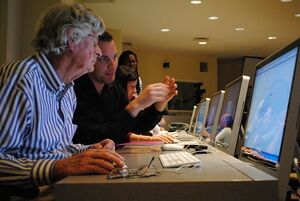Sedentary Behaviour: Difference between revisions
(REVIEW , AND UP-TO-DATE REFERENCE) |
(REVIEW , AND UP-TO-DATE REFERENCE and reformat) |
||
| Line 10: | Line 10: | ||
== Risky Behaviour == | == Risky Behaviour == | ||
[[File:Computer Class Elderly.jpg|thumb|Seated office work, a sedentary behaviour ]] | [[File:Computer Class Elderly.jpg|thumb|Seated office work, a sedentary behaviour ]] | ||
Excess SB is a risky behaviour. It has many adverse health effects, for example: elevated all-cause mortality; [[Cardiovascular Disease|cardiovascular disease]] mortality; [[Oncological Disorders|cancer]] risk; risks for [[Metabolic and Endocrine Disorders|metabolic disease]]<nowiki/>s such as [[diabetes]], [[hypertension]], [[Hyperlipidemia|dyslipidemia]], musculoskeletal diseases (e.g. [[Knee Osteoarthritis|knee pain]] and [[osteoporosis]]) and [[Mental Health|mental health]] problems. The negative health impacts escalate with increases in the total daily sedentary times. For this reason, it is important to reduce the SB.<ref>Park JH, Moon JH, Kim HJ, Kong MH, Oh YH. [https://www.ncbi.nlm.nih.gov/pmc/articles/PMC7700832/ Sedentary lifestyle: overview of updated evidence of potential health risks]. Korean journal of family medicine. 2020 Nov;41(6):365. Available: https://www.ncbi.nlm.nih.gov/pmc/articles/PMC7700832/<nowiki/>(accessed 10.10.2022)</ref> | Excess SB is a risky behaviour. It has many adverse health effects, for example: elevated all-cause mortality; [[Cardiovascular Disease|cardiovascular disease]] mortality; [[Oncological Disorders|cancer]] risk; risks for [[Metabolic and Endocrine Disorders|metabolic disease]]<nowiki/>s such as [[diabetes]], [[hypertension]], [[Hyperlipidemia|dyslipidemia]], musculoskeletal diseases (e.g. [[Knee Osteoarthritis|knee pain]] and [[osteoporosis]]) and [[Mental Health|mental health]] problems. The negative health impacts escalate with increases in the total daily sedentary times. For this reason, it is important to reduce the SB.<ref>Park JH, Moon JH, Kim HJ, Kong MH, Oh YH. [https://www.ncbi.nlm.nih.gov/pmc/articles/PMC7700832/ Sedentary lifestyle: overview of updated evidence of potential health risks]. Korean journal of family medicine. 2020 Nov;41(6):365. Available: https://www.ncbi.nlm.nih.gov/pmc/articles/PMC7700832/<nowiki/>(accessed 10.10.2022)</ref><ref>Lowe A, Littlewood C, McLean S. Understanding physical activity promotion in physiotherapy practice: A qualitative study. Musculoskeletal Science and Practice. 2018 Jun 1;35:1-7.</ref> | ||
== Sedentary Behaviour vs Physical Inactivity == | == Sedentary Behaviour vs Physical Inactivity == | ||
| Line 31: | Line 31: | ||
* Reduce the time they spend being sedentary. | * Reduce the time they spend being sedentary. | ||
* Stand on public transport | * Stand on public transport. | ||
* Encourager [[Active Transportation and Planetary Health|active transport]] e.g. [[Cycling: Active Transport|cycling]] | * Encourager [[Active Transportation and Planetary Health|active transport]] e.g. [[Cycling: Active Transport|cycling]]. | ||
* Walk/walk part way to work | * Walk/walk part way to work. | ||
* Walk during lunch breaks and/or breaks | * Walk during lunch breaks and/or breaks. | ||
* Stand up every 30 minutes when working at a desk | * Stand up every 30 minutes when working at a desk. | ||
* Use a standing desk or ask the workplace to provide one | * Use a standing desk or ask the workplace to provide one. | ||
* Increase the manual chores done around the house | * Increase the manual chores done around the house. | ||
* Walk around when taking phone calls | * Walk around when taking phone calls. | ||
* Join community/friend activity groups in free time rather than watching television or playing video games | * Join community/friend activity groups in free time rather than watching .television or playing video games. | ||
* Get a dog and walk regularly | * Get a dog and walk regularly. | ||
* Take the stairs instead of using the elevator | * Take the stairs instead of using the elevator. | ||
* Use an exercise bike in office/living room | * Use an exercise bike in office/living room. | ||
<div class="row"> | <div class="row"> | ||
<div class="col-md-6"> {{#ev:youtube|QvW5ETkhawc|400}} <div class="text-right"><ref>ISPAH . Webinar 2. Why and how to reduce sedentary behaviour?. Available from: http://www.youtube.com/watch?v=QvW5ETkhawc [last accessed 25/6/2023]</ref></div></div> | <div class="col-md-6"> {{#ev:youtube|QvW5ETkhawc|400}} <div class="text-right"><ref>ISPAH . Webinar 2. Why and how to reduce sedentary behaviour?. Available from: http://www.youtube.com/watch?v=QvW5ETkhawc [last accessed 25/6/2023]</ref></div></div> | ||
Latest revision as of 13:34, 14 July 2023
Original Editor - Lucinda hampton
Top Contributors - Lucinda hampton, Uchechukwu Chukwuemeka and Shaimaa Eldib
Introduction[edit | edit source]
Sedentary behaviour(SB) refers to “any walking behaviour characterised by an energy expenditure ≤1.5 metabolic equivalents (METs), while in a sitting, reclining or lying posture”. Many adults spend roughly 9–10 h/day engaging in sedentary behaviours. Given this level of exposure, an understanding of its relationship with health outcomes is vital for the general public.[1]
Risky Behaviour[edit | edit source]
Excess SB is a risky behaviour. It has many adverse health effects, for example: elevated all-cause mortality; cardiovascular disease mortality; cancer risk; risks for metabolic diseases such as diabetes, hypertension, dyslipidemia, musculoskeletal diseases (e.g. knee pain and osteoporosis) and mental health problems. The negative health impacts escalate with increases in the total daily sedentary times. For this reason, it is important to reduce the SB.[2][3]
Sedentary Behaviour vs Physical Inactivity[edit | edit source]
SBs are considered conceptually distinct from physical inactivity, with the latter meaning performing insufficient amounts of moderate-to-vigorous physical activity to meet current physical activity recommendations.[4]A person may engage in recommended time of PA, but be too sedentary in the remaining hours, adversely affecting health. e.g. A person may jog for 50 minutes daily and engage in SB the rest of the day.
WHO Guidelines[edit | edit source]
The WHO 2020 guidelines on physical activity and sedentary behaviour give new advice on sedentary behaviour and its interrelationships with physical activity. They provide a broader set of behavioural targets to help improve population health, aiming to limit sedentary behaviour and increase physical activity among those who need it most. These new sedentary behaviour guidelines hopefully will elicit more targeted research in this area and be a stimulus for more system-wide policies, programs, and initiatives to help improve global health.[4]
See WHO Physical activity guidelines here
Physiotherapy[edit | edit source]
Physical activity is essential for a healthy life and spending most of the day being sedentary is dangerous.
Physiotherapists are well positioned to advise people on healthy lifestyle choices[5]. Examples being
- Encourage clients to make physical activity a part of daily life during all stages of life.
- Reduce the time they spend being sedentary.
- Stand on public transport.
- Encourager active transport e.g. cycling.
- Walk/walk part way to work.
- Walk during lunch breaks and/or breaks.
- Stand up every 30 minutes when working at a desk.
- Use a standing desk or ask the workplace to provide one.
- Increase the manual chores done around the house.
- Walk around when taking phone calls.
- Join community/friend activity groups in free time rather than watching .television or playing video games.
- Get a dog and walk regularly.
- Take the stairs instead of using the elevator.
- Use an exercise bike in office/living room.
References[edit | edit source]
- ↑ Saunders TJ, McIsaac T, Douillette K, Gaulton N, Hunter S, Rhodes RE, Prince SA, Carson V, Chaput JP, Chastin S, Giangregorio L. Sedentary behaviour and health in adults: an overview of systematic reviews. Applied Physiology, Nutrition, and Metabolism. 2020;45(10):S197-217.Available:https://cdnsciencepub.com/doi/full/10.1139/apnm-2020-0272?rfr_dat=cr_pub++0pubmed&url_ver=Z39.88-2003&rfr_id=ori%3Arid%3Acrossref.org (accessed 10.10.2022)
- ↑ Park JH, Moon JH, Kim HJ, Kong MH, Oh YH. Sedentary lifestyle: overview of updated evidence of potential health risks. Korean journal of family medicine. 2020 Nov;41(6):365. Available: https://www.ncbi.nlm.nih.gov/pmc/articles/PMC7700832/(accessed 10.10.2022)
- ↑ Lowe A, Littlewood C, McLean S. Understanding physical activity promotion in physiotherapy practice: A qualitative study. Musculoskeletal Science and Practice. 2018 Jun 1;35:1-7.
- ↑ 4.0 4.1 Dempsey PC, Biddle SJ, Buman MP, Chastin S, Ekelund U, Friedenreich CM, Katzmarzyk PT, Leitzmann MF, Stamatakis E, van der Ploeg HP, Willumsen J. New global guidelines on sedentary behaviour and health for adults: broadening the behavioural targets. International Journal of Behavioral Nutrition and Physical Activity. 2020 Dec;17(1):1-2.Available:https://ijbnpa.biomedcentral.com/articles/10.1186/s12966-020-01044-0 (accessed 10.10.2022)
- ↑ Delany C, Fryer C, van Kessel G. An ethical approach to health promotion in physiotherapy practice. Health Promotion Journal of Australia. 2015 Oct 27;26(3):255-62.
- ↑ ISPAH . Webinar 2. Why and how to reduce sedentary behaviour?. Available from: http://www.youtube.com/watch?v=QvW5ETkhawc [last accessed 25/6/2023]
- ↑ Stanford Medicine. Sedentary Behavior - Target for Change, Challenge to Assess . Available from: http://www.youtube.com/watch?v=qondXFSjPPA [last accessed 25/6/2023]












